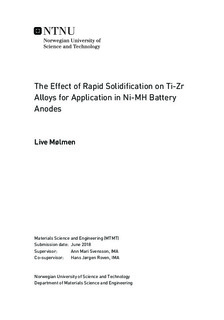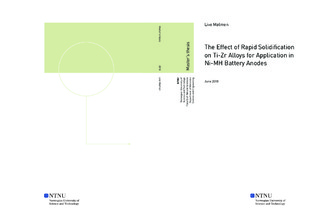| dc.description.abstract | Metal hydrides find applications in the storage of hydrogen and also as anode materials for
the nickel-metal hydride batteries(Ni-MH). The properties of these materials can be tuned
by selecting appropriate elemental composition and by controlling the microstructure. The
overall goal in the development of advanced metal hydrides is to obtain materials with high
hydrogen storage capacity, fast and completely reversible hydrogen absorption and desorption,
and tunable phase stability (with an adsorption/desorption pressure around 1 bar at
ambient conditions for the Ni-MH batteries), as well as good stability in the working environment
(6-9 M KOH electrolyte in Ni-MH batteries).
The goal of the present work was to study the effect of rapid solidification(RS) as a
nanostructuring technology applied to obtain novel and improved anode materials for the
Ni-MH battery. The focus of the work was on the TiZr-based AB2 Laves phase alloys, which
contain significantly less rare earth metals (RE) compared to the commercialized alloys used
today, which has the composition (RE(Ni,Co)5). The alloys were melt spun to obtain a
grain refinement, and consequently improve the discharge capacity and high rate discharge
performance of the alloys.
Based on earlier experiments performed at IFE, two basic alloys with compositions
(TixZr1-xLay)(Ni1.2Mn0.7V0.12Fe0.12) were chosen. Particular compositions were selected as
x=0.15, and y=0.03 (Alloy 1), and x=0.2 and y=0.01 (Alloy 2). Both alloys contain minor
amounts of La to help achieving fast activation of the material.
The alloys were melt spun, with wheel surface speeds varying from 3.1-62.8 m/s. As the
melt spinning process proved to modify the alloy composition, resulting in depletion of Mn
which is easily vaporized, the effect of excess Mn addition to mitigate this problem was also
studied for alloy 1. The effect of RS on the microstructure and phase compositions was characterized
by using SEM, EDS, AES and XRD. Furthermore, the electrochemical properties
were studied through electrochemical cycling performed at different current densities as well
as by electrochemical impedance spectroscopy and PCT.
The SEM studies showed a successful refinement of the microstructure by RS. The grain
size gradually decreased from the original 2 μm in the as cast alloys to around 250 nm for
the alloys melt spun with the highest cooling rate. The morphology of alloy 1 showed an
isotropic reduction in grain size with RS, with a related formation of small particles of the
secondary phases at the grain boundaries. Alloy 2, on the other hand, showed a formation of a lamellar structure after the melt spinning.
The XRD data show that both alloys contain a mixture of two Laves phase compounds;
cubic C15 and hexagonal C14 structure. The preferred C15 crystal structure is dominating
for the initial alloys. RS however increases the amount of the C14 phase. The EDS and
XRD results confirm that the main phase observed in the SEM micrographs corresponds to
the C15 phase, while the particles or secondary phase consists of the C14 crystal structure.
Electrochemical results showed that RS casted samples have a more sluggish activation performance.
Furthermore, alloy 2 proved to have more sluggish activation than alloy 1, as well
as a sloped working potential.
Lastly, for alloy 1, the high rate of discharge performance was improved by RS, as there
is an increase in capacity for all tested current densities. This is a result of the refined
microstructure leading to an increased diffusion coefficient of H through the material. | |

